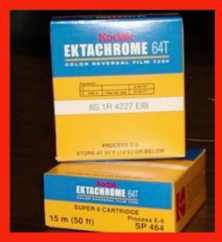|
Here is the new site for products and service: |
||||||||||||||||||||||||
|
movie.project-consultant.net |
||||||||||||||||||||||||
|
|
||||||||||||||||||||||||
|
|
||||||||||||||||||||||||
|
Super8 technology - film.project-consultant.net Mike´s cams |
|
|
||||||||||||||||||||||||||||||||
|
The Kodak Ektachrome 64T |
|
|
|
Super 8 is living further on, thanks to Kodak! Kodak´s announcement to withdraw the old Kodachrome 40 and move to the proven standard colour transparency film Ektachrome 64T also for Super 8 was a signal for the market that the time of Kodaks film processing at Lousanne will reach an end... this means also, that private owned companies worldwide can process the 64T film in E6 process. Maybe, this can increase the prices in some areas for Super8 filming. But for E6 processing there are more possibilities, maybe you do it by yourself? Some prices I have seen today are not really higher....and includes processing too. Important conditions for using this new film: First results with the new film and different cameras under different lightconditions shows that it is good to set the to the wright f/stop!. Under some conditions the colours ar too bright .....or/and too grainy. Unfortunately 64 ASA films are not common to the Super 8 camera makers late 80th and 90th. Most of them used a cartridge filmspeed checker for the only two common available speeds at this time: 40 and 160 ASA. Due to cost and comfort purposes they have “forgotten” the between steps, because they are not common available at this times from Agfa, Kodak, Perutz and all the others. Now the “in between step” will be the only common available colourfilm speed: 64 ASA! This means that most of automatic light meters checks a wrong film speed and gives also wrong aperture openings (2/3 more open)! If you want to learn more about ASA , DIN and ISO and aperture opening see here. . If your camera can not check the 64ASA filmspeed and you want the right f/stop, you have the choice: forget your automatic light meter (as some professionals do) and do everything manual (see manual metering), try to find other filmmaterial, check your cam, let modify your camera. Be happy if you have a camera which checks all ASA steps or which has a manual correction possibility. But there are some superior cameras for professional usage on the market from ELMO, Bosch/Bauer and some others which don´t have this possibilities - they are too comfortabel - for today. (Note: some manuals are wrong! - see Bauer cameras.) For the fine Bauer or AGFA cameras and Nizo integral I have developed a feature to do manual correction of the actual exposement.......also to lower 2/3 of an f/stop. This feature I call ADAMS64 Older cameras from BAUER, CANON, CARENA, CHINON, COSINA, GAF, PORST, REVUE, SANKYO or some others are interesting now:
Best sample for this are the solid manufactories like BEAULIEU or the russian Zenith with QUARZ. They have never build “such electronic automatic devices for playing”. You have to - and you can - switch to the filmspeed you need. Its not interesting for the camera which kind of film is loaded. Very fine technology - from stoneage ! (I am technician but I like to drive also old cars without any electronical device, they are not so comfortable, but I can feel and I know what I am doing....and they have one big advantage: I am the “boss” ! Important to know is the fact, that old orange Wratten filters (85A or “type A”) differs slightly from 85B filters which are recommended from Kodak for the Ektachrome 64T film. If you transfer your film to digital you can forget it. You can change the colour with your software..... Most users can live with the old 85A filters. Users which want absolutely true colours needs to recognize colour temperature and maybe new filters 85B. I recommend to make a test with the new film. Be aware: due to age, old organic gelantine wratten filters are often clouded or dull and changes colours and/or sharpness. (see more..) For owners and professionals I have provided an overview for some super 8 cameras to see what to do, if you want to use the 64 ASA Ektachrome 64T Super8 film from KODAK. Searching for a “new” Super8 camera? You will find a list of interesting cameras, directly to use with the new KODAK 64T. f you have some details of other important cameras please mail.
|
| [S8 technology NEWS] [Old S8 techguide] [Film / HDV] [Tips for buyers] [bright / lowlight] [ASA DIN ISO] [Wratten filter] [shutter - speed - fade] [some tech - tips] [fungus] [sound and sync] [cameras for usage] [Links Contact] [my camera and Kodak] [long filmreels..] [Camera Store] [table: ASA -cameras] [Adams64 new cams] |
